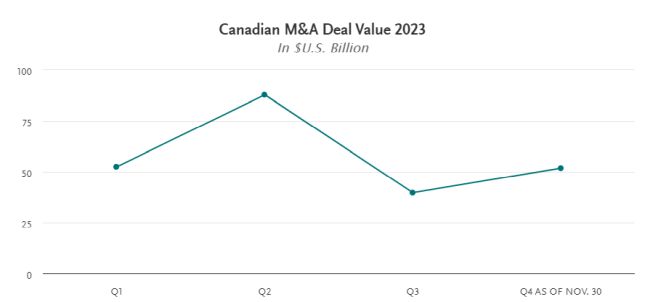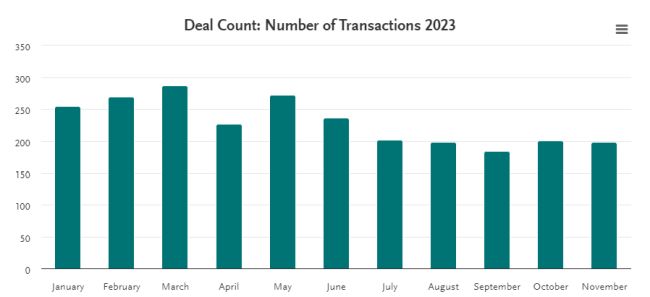While Canadian M&A activity continued to lag in 2023 as compared to 2021 and early 2022 in terms of transaction value and volume, as reflected in a significant downturn in exits in Q3, there remain a number of reasons for optimism for Canadian M&A as we move into 2024.
Mid-market Canadian M&A remained relatively active in 2023 amid the confluence of geopolitical tensions, rising inflation, higher interest rates, tighter credit markets and significantly reduced access to capital, with the power and utilities and oil & gas sectors leading the way on deal value, boosted by megadeals announced in Q3 and Q4.
The unpredictability in the Canadian M&A market is expected to extend into the new year but recent developments indicate that our M&A landscape north of the border may begin to rebound in 2024. M&A trends that we are following heading into the new year include:
- the effects of anticipated stabilization of interest rates and inflation in Canada and internationally, coupled with credit market participants being more confident in the cost of transacting;
- pronounced growth in Canadian private credit-backed transactions;
- ongoing deal activity in both the resource and energy sectors;
- renewed international investment in Canadian renewable energy projects;
- continued popularity of the use of secondaries and continuation funds as non-traditional exit options; and
- a rise in restructuring and distressed M&A opportunities across a variety of sectors.
2023 M&A Deal Activity
All numbers are according to Bloomberg data in U.S. dollars (announced, completed or pending deals—excluding those that have been terminated or withdrawn—where a Canadian company is the acquirer, target or seller) as of November 30, 2023.

As of November 30, there had been 2,528 M&A transactions involving a Canadian company, having an aggregate value of $231.84 billion, as compared to 3,424 transactions having a value of $280.65 billion in full-year 2022 (FY 2022).

While deal count generally slowed in the second half of 2023, the number and size of Canadian mid-market transactions (having a value from $20 million to $500 million) remained relatively consistent.
Canadian Mid-Market M&A 2023
$20 million to <$500 million in deal value
| Quarter | Deal Count | Deal Volume |
| Q4 (to Nov. 30) | 60 | $7.4 billion |
| Q3 | 63 | $7.1 billion |
| Q2 | 73 | $8.8 billion |
| Q1 | 58 | $7.5 billion |
The power and utilities sector has led the way in deal value this
year, with 30 deals having an aggregate value of $40.8 billion,
followed by software (194 deals; $26.5 billion value) and oil &
gas (56 deals; $23.7 billion value).
The mining sector has seen the highest number of transactions in 2023, with 643 deals having an aggregate value of $14.8 billion. Australian companies were the acquirers in 69 of these transactions (compared to 28 in FY 2022), representing one of the most notable trends in the Canadian mining industry of late.
Canadian M&A Trends to Watch in 2024
- Anticipated Interest Rate and Inflation Stabilization: Rapidly increasing interest rates and inflation for most of the last two years have been among the main contributors to the marked decline in M&A activity in recent quarters, where deal counts and values hit lows not seen in years. While megadeals were primarily affected by reduced access to capital and the tightening of credit markets for much of the year, the impact on the mid-market stemmed more from widening gaps between the valuation expectations of buyers and sellers, with buyers unwilling to take on the interest rate risk associated with the targeted multiples sought by sellers. While there is some market sentiment that rates will remain "higher for longer", they currently appear to have stabilized. The Bank of Canada announced on December 3 that it would maintain its benchmark interest rate at 5 percent and the U.S. Federal Reserve held its rate steady on December 13. Comments from both central banks indicate that rate cuts are coming in 2024, but the timing is yet to be determined. Even if we do not see material declines in the near future, reduced fears about increasing rates and inflation could act as a catalyst to bring dealmakers back to the table, ensuring credit markets remain active. This may have a particular impact with respect to PE exits, where high interest rates have caused many sponsors to hold their positions until valuations improve rather than seeking immediate liquidity in traditional time horizons.
- Private Credit: One of the few bright points emerging from 2023's volatile interest rate environment has been a surge in private credit, which has been buoyed by the pullback of conventional lenders in the wake of this year's regional banking turmoil south of the border, and investors reallocating their portfolios away from traditional PE equity investments. The global private credit market now has US$1.6 trillion in assets under management, more than double its size in 2018,1 representing a significant source of capital for deal-making and offering a lifeline to struggling borrowers through mechanisms (such as PIK interest) that traditional banks cannot or will not provide. While there are several Canadian private credit funds that have been active in this space for many years (and continue to have success in fundraising for new funds) and there has been some increase in new private capital market participants, we have yet to see a significant uptick in private credit-backed deals at the level seen in the U.S. and Europe this year, and the higher end of the market where private credit has been used continues to be dominated by traditional U.S. players. We expect private credit to continue to carve out a larger share of the Canadian M&A deal landscape in 2024.
- Oil & Gas Deal Making: The oil & gas sector saw strong activity in 2023 and we believe this trend will continue in 2024, particularly if interest rates and inflation stabilize, making it easier to price transactions. While the energy transition remains a focus, we are seeing energy companies emphasize that the transition must take place within the context of core strategies that drive shareholder value, and market realities continue to drive global demand and pricing. As a result, we expect M&A activity in the sector will continue to be balanced, with capital investment deployed towards both efficiency and decarbonization opportunities. Although the size of the Canadian industry means there is limited scope for large acquisitions compared to the U.S., we anticipate that consolidation will continue to be a driver of Canadian M&A, with small and mid-cap companies expected to be more likely targets for larger strategic acquirers and investors in 2024, particularly in light of ample fossil fuel reserves, strong commodity prices and improving market access.
- International Interest in Canadian Renewables: The energy transition is also creating disruption and significant opportunities for M&A in the renewable energy space. There are indications of increasing foreign interest in Canadian renewable projects, with governments, sponsors and strategics looking for opportunities to invest in order to reduce their climate impact and pursue net-zero strategies. We expect there will be continued cross-sector transactions in 2024, including international downstream OEMs looking to secure critical minerals necessary for battery production and energy storage, and continued interest in hydrogen and ammonia, wind and solar projects. Given rising geopolitical risk and supply chain disruptions, as well as Canada's Clean Technology Investment Tax Credit, Canadian renewable projects will likely continue to be viewed as attractive investments by international investors and strategics.
- Secondaries and Continuation Funds: The slowdown in exits was one of the defining themes in private equity in 2023, with the value of exits falling in the third quarter to the second-lowest level since 2010.2 This has led to significant growth in the use of secondaries and GP-led continuation funds in recent years as tools to create optionality. These funds give investors the ability to sell their stake in a fund before its fixed end of term to free up cash or to remain invested in a business they believe in and enable sponsors to continue to hold strong assets until valuations become favorable rather than being forced to sell because a fund is reaching its term limit. Canadian players have been active in this space, with CPPIB, CDPQ and BCIMC all announcing proposed or completed sales of various assets in the secondaries market, and a number of secondaries-focused funds exceeding their capital raising targets this year. Although the structuring of GP-led continuation funds is complex, including because of inherent conflict of interest concerns due to GPs having an interest on both the buy- and sell-sides, we expect their use to grow in 2024, particularly given the increasing number of funds nearing end of life.
- Restructuring and Distressed M&A: After falling to record lows in 2020 and 2021, business insolvencies bounced back to historical averages in 2023 and are on pace to surpass those volumes in 2024. Q3 insolvency filings were up 41.8 percent year-over-year, accelerating by nearly 3 percent from Q2 to Q3, with both the pace and volume of filings continuing to accelerate into Q4.3 The combination of a relatively high interest rate environment and the end of COVID-related government supports has left many businesses with bloated balance sheets and limited liquidity. Lenders that were open to extending concessions during the pandemic years are showing an increasing willingness to take enforcement action. The result has been considerable restructuring activity across all sectors, with distressed acquisition opportunities coming to market in the mining, power, film and entertainment, pharmaceuticals, real estate and food and beverages industries (to name a few) in 2023, creating consolidation opportunities for incumbents, as well as deep value discounts for strategic investors willing to transact through court-supervised processes.
In addition, the 2024 U.S. presidential election is less than a year away and will undoubtedly impact M&A activity, particularly with respect to transactions that may be subject to regulatory scrutiny. We expect to have further comments on this topic in our quarterly updates next year.
What's Needed for an M&A Rebound in 2024?
Although current economic and political challenges are expected to continue into 2024, we believe the stage is set for revitalized Canadian M&A activity next year. More certainty around interest rates and inflation is expected to narrow the perceived valuation gap between buyers and sellers. The volatility experienced throughout 2023 has led dealmakers to become increasingly creative in devising structures that permit the allocation of capital in a manner that enables transactions to be completed, and there is continued interest in smaller consolidation strategies and add-on deals that can be accomplished without significant financing risk. Unutilized capital remains very high and the slowdown in exits is putting pressure on private equity firms to deploy capital and to achieve liquidity, creating demand on both the buy and sell sides for when conditions improve.
The trends we are following reflect emerging bright spots in the shadows that have befallen the M&A landscape over the last two years, and we are optimistic for a solid rebound of activity in 2024.
Footnotes
1. Wall Street Journal, "Private credit's rising tide," November 29, 2023
2. Pitchbook, US PE Breakdown Q3 2023, October 10, 2023
3. Office of the Superintendent of Bankruptcy
The content of this article is intended to provide a general guide to the subject matter. Specialist advice should be sought about your specific circumstances.





